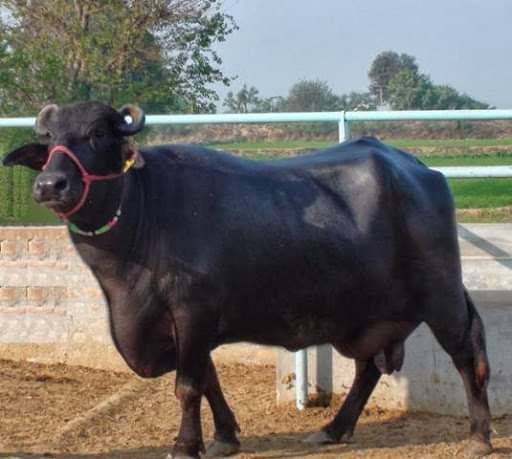HEAT STRESS IN BUFFALOES DURING SUMMER AND ITS MANAGEMENT: AN OVERVIEW
Bhavna Aharwal1, Kiran Pal Singh Saini2, Sandeep Shrivastav3, Divya Patel4, Govind Choudary5
1.PhD Scholar, Department of Livestock Production and Management, COVSc & A.H., Jabalpur, M.P. India
2. Junior Scientist, Krishi Vigyan Kendra, Seoni, JNKVV, Jabalpur, M.P. India
3.Veterinary Officer, NDRF India
4.Teaching Associate, Department of Livestock Production and Management, Apolo Veterinary College, Jaipur, India
5.M.VSc Scholar, COVSc & A.H., Jabalpur, M.P. India
1. Introduction:
During the month of May and June, the period of midday is too much sunny, hot and painful. Only some relief is observe when day ends but the evening is again comparatively warm. In such weather, the owners of buffalo need to keep some specific attention in their mind to make their herd comfortable. Cleanliness and management of animals with their shed provides protection against various diseases incidence.
2. General management of shed:
The important things to be consider is that the buffaloes should not be allowed to move freely during day hours because they need protection against warm air storms and direct sun exposure and they should be sheltered in cool and shady places. The buffalo shed should be ventilated that the polluted air can directly diffused outside and clean and fresh air can enter into it. The roof of the shelter is covered with thatch. The proper plantation should be managed in surroundings so that the environment may be cool and fresh and warm air storm could not enter directly in the shed. Regular use of foggers or sprinklers in summer is recommended to make the environment cool. The buffalo needs at least twice a day bath in the summer. The animals are subjected to detect estrus on time to increase their productivity. Pregnant buffaloes need specific care during summer.
3. Heat Tolerance:
Although buffaloes are found in the tropics and subtropics still have poor heat resistance and suffer real distress if worked during the day hours. Access of free water or shade is essential for the well being of buffaloes. There should have the facility of wallowing tank near by shed in the farm. Milking animals must have clean drinking water to avoid dehydration at any time. It is thus to be noted that sudden changes of temperature and specially to the effect of cold winds and draughts may be extremely harmful to this species. In managemental practice it should be keep in mind that heat regulating mechanism of buffaloes in comparison to cattle are less efficient. The difference may be due in part to the heavy black coat of the cow preventing wetting of the skin, but more probably to the fact that the thyroid-adrenal mechanism is less efficient in the buffaloes.
4. Housing Management:
The floor of the buffalo shed should be clean, non slippery, non reactive, non absorbable, concreted and comfortable to the animals. It should be designed either tail to tail or head to head system so cleaning at any time will be easily with desirable slop and economic for the farmer. The site selection for shed with adequate paddock space, fresh air, sufficient natural light, fresh water, electricity, proper drainage system should be properly managed. The site should be having easy connecting roads for better transportation facilities but away from the main roads to keep the buffalo farm free from the noise pollution. A buffalo shed should be established at an open area away from the population and industrial surroundings. Usually two types to buffalo houses are commonly used in our country.
4.1. Conventional housing system:
In this type of housing system all the animals are tied near to each other. They receive their feed in manger and a small paddock system. If the number of the animals is below 16 they can be tied in the single row. In case if they more than that, they can be tied in two rows. In this system their tails are in the direction towards to each other. The removal of feces, urine and other waste material routed from same way but the feed from two separate ways. This system requires 2.25 square meter of space per animal. The path between two rows needs to be 1.50 m. in width and the path to mangers 0.90 m.
4.2. Loose housing system:
In this type housing system the animals are let loose in the shed. They can move freely here and there. The buffaloes are transferred to milk shed and tied only at the time of milking. The shed is covered with a fence as high as 2 m. The mangers are constructed on the boundary so that the adlib feed can be offered from outside the shed. The water tough is situated in the centre of the shed and each every animal has a free access to water as per need and desire.
It is very much important to maintain buffalo shelter management of high grade to earn profits. The buffalo house should have adequate space, so that the animals can be sheltered contentedly. The sufficient light and fresh air ought to be assessed in the buffalo house. The animal shed must be spotless and uninterrupted free access to fresh water be supposed to always be available to each animal. The specification of total space requirements of buffaloes areas:
Table 1 . Space requirement for various classes of buffalo in open paddocks
Animal class Covered area (square feet) Open area (square feet) Length of Mangers
Female buffalo 25-35 80-100 20-24
Calves 15-20 50-60 15-20
Pregnant buffalo 100-120 180-200 24-30
Buffalo bulls 120-140 200-250 24-30
Conclusion
Keeping all the above view facts points in mind. Animal productivity can be enhanced by ameliorating the floor and roof housing pattern with wallowing and bathing. During extreme environmental stress i.e., summer. Animal in comfort zone can eliminate the stress so that it can perform at its best. Heat stress is a temporary problem and by certain management we can maintain animal health as well as its productivity


